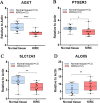Identification of the key genes and pathways involved in the tumorigenesis and prognosis of kidney renal clear cell carcinoma
- PMID: 32144299
- PMCID: PMC7060270
- DOI: 10.1038/s41598-020-61162-4
Identification of the key genes and pathways involved in the tumorigenesis and prognosis of kidney renal clear cell carcinoma
Abstract
Kidney renal clear cell carcinoma (KIRC) is the most common renal cell carcinoma (RCC). However, patients with KIRC usually have poor prognosis due to limited biomarkers for early detection and prognosis prediction. In this study, we analysed key genes and pathways involved in KIRC from an array dataset including 26 tumour and 26 adjacent normal tissue samples. Weighted gene co-expression network analysis (WGCNA) was performed with the WGCNA package, and 20 modules were characterized as having the highest correlation with KIRC. The upregulated genes in the tumour samples are involved in the innate immune response, whereas the downregulated genes contribute to the cellular catabolism of glucose, amino acids and fatty acids. Furthermore, the key genes were evaluated through a protein-protein interaction (PPI) network combined with a co-expression network. The comparatively lower expression of AGXT, PTGER3 and SLC12A3 in tumours correlates with worse prognosis in KIRC patients, while higher expression of ALOX5 predicts reduced survival. Our integrated analysis illustrated the hub genes involved in KIRC tumorigenesis, shedding light on the development of prognostic markers. Further understanding of the function of the identified KIRC hub genes could provide deep insights into the molecular mechanisms of KIRC.
Conflict of interest statement
The authors declare no competing interests.
Figures








Similar articles
-
Systematic analysis of alternative splicing signature unveils prognostic predictor for kidney renal clear cell carcinoma.J Cell Physiol. 2019 Dec;234(12):22753-22764. doi: 10.1002/jcp.28840. Epub 2019 May 29. J Cell Physiol. 2019. PMID: 31140607 Free PMC article.
-
Comprehensive characterization of immune- and inflammation-associated biomarkers based on multi-omics integration in kidney renal clear cell carcinoma.J Transl Med. 2019 May 27;17(1):177. doi: 10.1186/s12967-019-1927-y. J Transl Med. 2019. PMID: 31133033 Free PMC article.
-
Comprehensive analysis on the expression levels and prognostic values of LOX family genes in kidney renal clear cell carcinoma.Cancer Med. 2020 Nov;9(22):8624-8638. doi: 10.1002/cam4.3472. Epub 2020 Sep 24. Cancer Med. 2020. PMID: 32970930 Free PMC article.
-
MicroRNAs in Renal Cell Carcinoma.Microrna. 2015;4(1):26-35. doi: 10.2174/2211536604666150713105247. Microrna. 2015. PMID: 26165467 Review.
-
Oncometabolites in renal cancer.Nat Rev Nephrol. 2020 Mar;16(3):156-172. doi: 10.1038/s41581-019-0210-z. Epub 2019 Oct 21. Nat Rev Nephrol. 2020. PMID: 31636445 Free PMC article. Review.
Cited by
-
Genome-Wide Comparison of the Target Genes of the Reactive Oxygen Species and Non-Reactive Oxygen Species Constituents of Cold Atmospheric Plasma in Cancer Cells.Cancers (Basel). 2020 Sep 16;12(9):2640. doi: 10.3390/cancers12092640. Cancers (Basel). 2020. PMID: 32947888 Free PMC article.
-
Characterization and verification of MMP family members as potential biomarkers in kidney clear cell renal carcinoma.Am J Cancer Res. 2023 Sep 15;13(9):3941-3962. eCollection 2023. Am J Cancer Res. 2023. PMID: 37818055 Free PMC article.
-
Identification of the Key Genes Involved in the Tumorigenesis and Prognosis of Prostate Cancer.Comput Math Methods Med. 2022 Oct 5;2022:5500416. doi: 10.1155/2022/5500416. eCollection 2022. Comput Math Methods Med. 2022. PMID: 36245843 Free PMC article.
-
Several first-line anti-hypertensives act on fibrosarcoma progression and PD1ab blockade therapy.J Orthop Surg Res. 2024 Feb 19;19(1):147. doi: 10.1186/s13018-024-04627-w. J Orthop Surg Res. 2024. PMID: 38373964 Free PMC article.
-
Identification of RNA-binding protein YBX3 as an oncogene in clear cell renal cell carcinoma.Funct Integr Genomics. 2023 Jul 7;23(3):225. doi: 10.1007/s10142-023-01145-6. Funct Integr Genomics. 2023. PMID: 37418046 Free PMC article.
References
Publication types
MeSH terms
Substances
LinkOut - more resources
Full Text Sources
Medical

